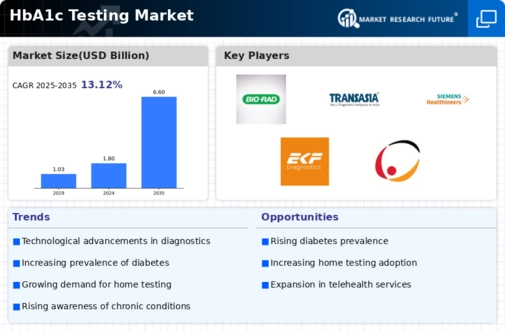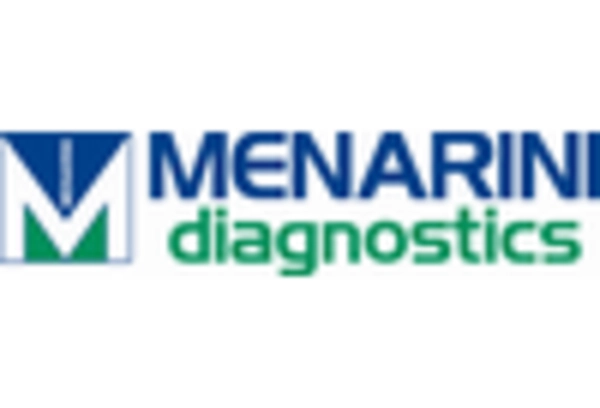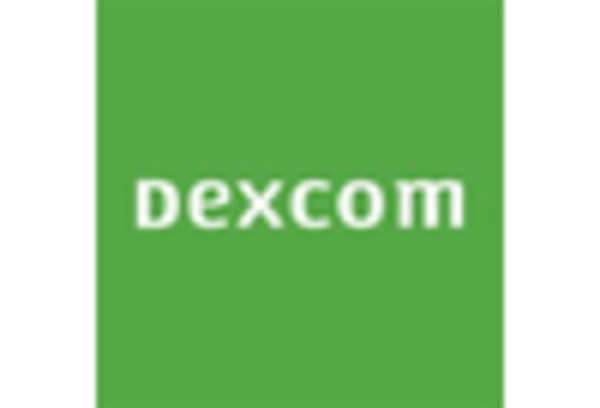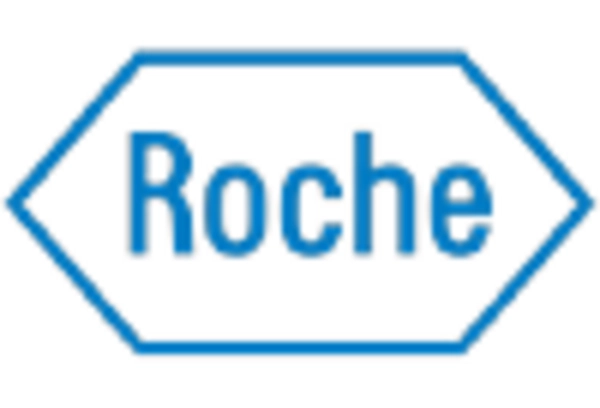-
MARKET SYNOPSIS 14
-
MARKET ATTRACTIVENESS ANALYSIS 15
-
GLOBAL HBA1C TESTING MARKET, BY PRODUCT 16
-
GLOBAL HBA1C TESTING MARKET, BY TECHNOLOGY 17
-
GLOBAL HBA1C TESTING MARKET, BY END USER 18
-
Market Introduction
-
DEFINITION 19
-
SCOPE OF THE STUDY 19
-
RESEARCH OBJECTIVE 19
-
MARKET STRUCTURE 20
-
ASSUMPTIONS & LIMITATIONS 20
-
Research Methodology
-
DATA MINING 21
-
SECONDARY RESEARCH 22
-
PRIMARY RESEARCH 23
-
BREAKDOWN OF PRIMARY RESPONDENTS 24
-
FORECASTING TECHNIQUES 25
-
RESEARCH METHODOLOGY FOR MARKET SIZE ESTIMATION 26
- BOTTOM-UP APPROACH 27
- TOP-DOWN APPROACH 27
-
DATA TRIANGULATION 28
-
VALIDATION 28
-
MARKET DYNAMICS
-
OVERVIEW 29
-
DRIVERS 30
- RISING PREVALENCE OF DIABETES 30
- INCREASING INITIATIVES BY KEY PLAYERS 30
- GROWING NUMBER OF RESEARCH ORGANIZATIONS AND ASSOCIATIONS FOR DIABETES 30
- INCREASING GERIATRIC POPULATION AND THE INFLUENCE OF SEDENTARY LIFESTYLE AND UNHEALTHY DIET 30
-
RESTRAINTS 32
- LIMITED INDICATIONS OF HBA1C TESTS 32
- STRINGENT REIMBURSEMENT POLICIES IN DEVELOPING COUNTRIES 32
-
OPPORTUNITIES 33
- INCREASING APPROVALS AND PRODUCT LAUNCHES 33
- INCORPORATION OF VARIOUS TECHNOLOGIES IN HBA1C TESTING INSTRUMENTS 33
-
MARKET FACTOR ANALYSIS
-
PORTER’S FIVE FORCES MODEL 34
- THREAT OF NEW ENTRANTS 34
- BARGAINING POWER OF SUPPLIERS 35
- THREAT OF SUBSTITUTES 35
- BARGAINING POWER OF BUYERS 35
- INTENSITY OF RIVALRY 35
-
VALUE CHAIN ANALYSIS 36
- R&D AND DESIGNING 37
- MANUFACTURING 37
- DISTRIBUTION 37
- MARKETING & SALES 37
- POST-SALES MONITORING 37
-
HBA1C TESTING MARKET, BY PRODUCT
-
OVERVIEW 38
-
REAGENTS & KITS 39
-
INSTRUMENTS 40
- BENCH-TOP DEVICE 41
- HANDHELD DEVICE 42
-
HBA1C TESTING MARKET, BY TECHNOLOGY
-
OVERVIEW 43
-
ION-EXCHANGE HPLC 44
-
ENZYMATIC ASSAY 45
-
TURBIDIMETRIC INHIBITION IMMUNOASSAY (TINIA) 46
-
OTHERS 46
-
HBA1C TESTING MARKET, BY END USER
-
OVERVIEW 47
-
HOSPITALS AND CLINICS 48
-
DIAGNOSTIC LABORATORIES 49
-
OTHERS 49
-
GLOBAL HBA1C TESTING MARKET, BY REGION
-
OVERVIEW 50
-
AMERICAS 52
-
HBA1C TESTING MARKET, BY PRODUCT
-
HBA1C TESTING MARKET, BY TECHNOLOGY
-
HBA1C TESTING MARKET, BY END USER
-
OVERVIEW 52
-
NORTH AMERICA 55
-
HBA1C TESTING MARKET, BY PRODUCT
-
HBA1C TESTING MARKET, BY TECHNOLOGY
-
HBA1C TESTING MARKET, BY END USER
-
US 58
-
HBA1C TESTING MARKET, BY PRODUCT
-
HBA1C TESTING MARKET, BY TECHNOLOGY
-
HBA1C TESTING MARKET, BY END USER
-
CANADA 60
-
HBA1C TESTING MARKET, BY PRODUCT
-
HBA1C TESTING MARKET, BY TECHNOLOGY
-
HBA1C TESTING MARKET, BY END USER
-
LATIN AMERICA 62
-
HBA1C TESTING MARKET, BY PRODUCT
-
HBA1C TESTING MARKET, BY TECHNOLOGY
-
HBA1C TESTING MARKET, BY END USER
-
EUROPE 64
-
HBA1C TESTING MARKET, BY PRODUCT
-
HBA1C TESTING MARKET, BY TECHNOLOGY
-
HBA1C TESTING MARKET, BY END USER
-
OVERVIEW 64
-
WESTERN EUROPE 67
-
HBA1C TESTING MARKET, BY PRODUCT
-
HBA1C TESTING MARKET, BY TECHNOLOGY
-
HBA1C TESTING MARKET, BY END USER
-
UK 70
-
HBA1C TESTING MARKET, BY PRODUCT
-
HBA1C TESTING MARKET, BY TECHNOLOGY
-
HBA1C TESTING MARKET, BY END USER
-
GERMANY 72
-
HBA1C TESTING MARKET, BY PRODUCT
-
HBA1C TESTING MARKET, BY TECHNOLOGY
-
HBA1C TESTING MARKET, BY END USER
-
FRANCE 74
-
HBA1C TESTING MARKET, BY PRODUCT
-
HBA1C TESTING MARKET, BY TECHNOLOGY
-
HBA1C TESTING MARKET, BY END USER
-
ITALY 76
-
HBA1C TESTING MARKET, BY PRODUCT
-
HBA1C TESTING MARKET, BY TECHNOLOGY
-
HBA1C TESTING MARKET, BY END USER
-
SPAIN 78
-
HBA1C TESTING MARKET, BY PRODUCT
-
HBA1C TESTING MARKET, BY TECHNOLOGY
-
HBA1C TESTING MARKET, BY END USER
-
REST OF WESTERN EUROPE 80
-
HBA1C TESTING MARKET, BY PRODUCT
-
HBA1C TESTING MARKET, BY TECHNOLOGY
-
HBA1C TESTING MARKET, BY END USER
-
EASTERN EUROPE 82
-
HBA1C TESTING MARKET, BY PRODUCT
-
HBA1C TESTING MARKET, BY TECHNOLOGY
-
HBA1C TESTING MARKET, BY END USER
-
ASIA-PACIFIC 84
-
HBA1C TESTING MARKET, BY PRODUCT
-
HBA1C TESTING MARKET, BY TECHNOLOGY
-
HBA1C TESTING MARKET, BY END USER
-
OVERVIEW 84
-
CHINA 87
-
HBA1C TESTING MARKET, BY PRODUCT
-
HBA1C TESTING MARKET, BY TECHNOLOGY
-
HBA1C TESTING MARKET, BY END USER
-
INDIA 89
-
HBA1C TESTING MARKET, BY PRODUCT
-
HBA1C TESTING MARKET, BY TECHNOLOGY
-
HBA1C TESTING MARKET, BY END USER
-
JAPAN 91
-
HBA1C TESTING MARKET, BY PRODUCT
-
HBA1C TESTING MARKET, BY TECHNOLOGY
-
HBA1C TESTING MARKET, BY END USER
-
SOUTH KOREA 93
-
HBA1C TESTING MARKET, BY PRODUCT
-
HBA1C TESTING MARKET, BY TECHNOLOGY
-
HBA1C TESTING MARKET, BY END USER
-
AUSTRALIA 95
-
HBA1C TESTING MARKET, BY PRODUCT
-
HBA1C TESTING MARKET, BY TECHNOLOGY
-
HBA1C TESTING MARKET, BY END USER
-
REST OF ASIA-PACIFIC 97
-
HBA1C TESTING MARKET, BY PRODUCT
-
HBA1C TESTING MARKET, BY TECHNOLOGY
-
HBA1C TESTING MARKET, BY END USER
-
MIDDLE EAST & AFRICA 99
-
HBA1C TESTING MARKET, BY PRODUCT
-
HBA1C TESTING MARKET, BY TECHNOLOGY
-
HBA1C TESTING MARKET, BY END USER
-
OVERVIEW 99
-
MIDDLE EAST 102
-
HBA1C TESTING MARKET, BY PRODUCT
-
HBA1C TESTING MARKET, BY TECHNOLOGY
-
HBA1C TESTING MARKET, BY END USER
-
AFRICA 104
-
HBA1C TESTING MARKET, BY PRODUCT
-
HBA1C TESTING MARKET, BY TECHNOLOGY
-
HBA1C TESTING MARKET, BY END USER
-
COMPETITIVE LANDSCAPE
-
OVERVIEW 106
-
COMPANY SHARE ANALYSIS, 2020 (%) 106
-
COMPANY PROFILES
-
ABBOTT LABORATORIES 108
- COMPANY OVERVIEW 108
- FINANCIAL OVERVIEW 108
- PRODUCTS/SERVICES OFFERED 109
- ABBOTT LABORATORIES: KEY DEVELOPMENTS 109
- SWOT ANALYSIS 109
- KEY STRATEGIES 110
-
BIO-RAD LABORATORIES, INC. 111
- COMPANY OVERVIEW 111
- FINANCIAL OVERVIEW 111
- PRODUCTS/SERVICES OFFERED 112
- KEY DEVELOPMENTS 112
- SWOT ANALYSIS 113
- KEY STRATEGIES 113
-
DANAHER CORPORATION 114
- COMPANY OVERVIEW 114
- FINANCIAL OVERVIEW 114
- PRODUCTS/SERVICES OFFERED 115
- KEY DEVELOPMENTS 115
- SWOT ANALYSIS 115
- KEY STRATEGIES 115
-
F. HOFFMANN-LA ROCHE LTD 116
- COMPANY OVERVIEW 116
- FINANCIAL OVERVIEW 116
- PRODUCTS/SERVICES OFFERED 117
- KEY DEVELOPMENTS 117
- SWOT ANALYSIS 117
- KEY STRATEGIES 118
-
SIEMENS HEALTHINEERS 119
- COMPANY OVERVIEW 119
- FINANCIAL OVERVIEW 119
- PRODUCTS/SERVICES OFFERED 120
- KEY DEVELOPMENTS 120
- SWOT ANALYSIS 120
- KEY STRATEGIES 121
-
EKF DIAGNOSTICS 122
- COMPANY OVERVIEW 122
- FINANCIAL OVERVIEW 122
- PRODUCTS/SERVICES OFFERED 123
- KEY DEVELOPMENTS 123
- SWOT ANALYSIS 123
- KEY STRATEGIES 124
-
-
ARKRAY, INC. 125
- COMPANY OVERVIEW 125
- ARKRAY, INC.: FINANCIAL OVERVIEW 125
- PRODUCTS/SERVICES OFFERED 125
- KEY DEVELOPMENTS 125
- SWOT ANALYSIS 126
- KEY STRATEGIES 126
-
TRINITY BIOTECH PLC. 127
- COMPANY OVERVIEW 127
- FINANCIAL OVERVIEW 127
- PRODUCTS/SERVICES OFFERED 128
- KEY DEVELOPMENTS 128
- SWOT ANALYSIS 128
- KEY STRATEGIES 128
-
PTS DIAGNOSTICS 129
- COMPANY OVERVIEW 129
- FINANCIAL OVERVIEW 129
- PRODUCTS/SERVICES OFFERED 129
- KEY DEVELOPMENTS 129
- SWOT ANALYSIS 130
- KEY STRATEGIES 130
-
DIASYS DIAGNOSTIC SYSTEMS GMBH 131
- COMPANY OVERVIEW 131
- FINANCIAL OVERVIEW 131
- PRODUCTS/SERVICES OFFERED 131
- KEY DEVELOPMENTS 131
- SWOT ANALYSIS 132
- KEY STRATEGIES 132
-
APPENDIX
-
REFERENCES 133
-
RELATED REPORTS 133
-
List of Tables
-
LIST OF ASSUMPTIONS 20
-
PRIMARY INTERVIEWS AND INFORMATION GATHERING PROCESS 24
-
GLOBAL HBA1C TESTING MARKET, BY PRODUCT, 2020–2027 (USD MILLION) 39
-
GLOBAL HBA1C TESTING MARKET FOR INSTRUMENTS, BY REGION, 2020–2027 (USD MILLION) 40
-
GLOBAL HBA1C TESTING MARKET FOR INSTRUMENTS, BY TYPE, 2020–2027 (USD MILLION) 40
-
GLOBAL HBA1C TESTING MARKET FOR INSTRUMENTS, BY REGION, 2020–2027 (USD MILLION) 41
-
GLOBAL HBA1C TESTING MARKET FOR BENCH-TOP DEVICE, BY REGION, 2020–2027 (USD MILLION) 41
-
GLOBAL HBA1C TESTING MARKET FOR HANDHELD DEVICE, BY REGION, 2020–2027 (USD MILLION) 42
-
GLOBAL HBA1C TESTING MARKET, BY TECHNOLOGY, 2020–2027 (USD MILLION) 44
-
GLOBAL HBA1C TESTING MARKET FOR ION-EXCHANGE HPLC, BY REGION, 2020–2027 (USD MILLION) 45
-
GLOBAL HBA1C TESTING MARKET FOR ENZYMATIC ASSAY, BY REGION, 2020–2027 (USD MILLION) 45
-
GLOBAL HBA1C TESTING MARKET FOR TURBIDIMETRIC INHIBITION IMMUNOASSAY (TINIA), BY REGION,
-
GLOBAL HBA1C TESTING MARKET, BY END USER, 2020–2027 (USD MILLION) 48
-
GLOBAL HBA1C TESTING MARKET FOR HOSPITALS AND CLINICS, BY REGION, 2020–2027 (USD MILLION) 48
-
GLOBAL HBA1C TESTING MARKET FOR DIAGNOSTIC LABORATORIES, BY REGION, 2020–2027 (USD MILLION) 49
-
GLOBAL HBA1C TESTING MARKET, BY REGION, 2020–2027 (USD MILLION) 51
-
AMERICAS: HBA1C TESTING MARKET, BY REGION, 2020–2027 (USD MILLION) 53
-
AMERICAS: HBA1C TESTING MARKET, BY PRODUCT, 2020–2027 (USD MILLION) 53
-
AMERICAS: HBA1C TESTING MARKET FOR INSTRUMENTS, BY TYPE, 2020–2027 (USD MILLION) 53
-
AMERICAS: HBA1C TESTING MARKET, BY TECHNOLOGY, 2020–2027 (USD MILLION) 54
-
AMERICAS: HBA1C TESTING MARKET, BY END USER, 2020–2027 (USD MILLION) 54
-
NORTH AMERICA: HBA1C TESTING MARKET, BY COUNTRY, 2020–2027 (USD MILLION) 55
-
NORTH AMERICA: HBA1C TESTING MARKET, BY PRODUCT, 2020–2027 (USD MILLION) 56
-
NORTH AMERICA: HBA1C TESTING MARKET FOR INSTRUMENTS, BY TYPE, 2020–2027 (USD MILLION) 56
-
NORTH AMERICA: HBA1C TESTING MARKET, BY TECHNOLOGY, 2020–2027 (USD MILLION) 57
-
NORTH AMERICA: HBA1C TESTING MARKET, BY END USER, 2020–2027 (USD MILLION) 57
-
US: HBA1C TESTING MARKET, BY PRODUCT, 2020–2027 (USD MILLION) 58
-
US: HBA1C TESTING MARKET FOR INSTRUMENTS, BY TYPE, 2020–2027 (USD MILLION) 58
-
US: HBA1C TESTING MARKET, BY TECHNOLOGY, 2020–2027 (USD MILLION) 59
-
US: HBA1C TESTING MARKET, BY END USER, 2020–2027 (USD MILLION) 59
-
CANADA: HBA1C TESTING MARKET, BY PRODUCT, 2020–2027 (USD MILLION) 60
-
CANADA: HBA1C TESTING MARKET FOR INSTRUMENTS, BY TYPE, 2020–2027 (USD MILLION) 60
-
CANADA: HBA1C TESTING MARKET, BY TECHNOLOGY, 2020–2027 (USD MILLION) 61
-
CANADA: HBA1C TESTING MARKET, BY END USER, 2020–2027 (USD MILLION) 61
-
LATIN AMERICA: HBA1C TESTING MARKET, BY PRODUCT, 2020–2027 (USD MILLION) 62
-
LATIN AMERICA: HBA1C TESTING MARKET FOR INSTRUMENTS, BY TYPE, 2020–2027 (USD MILLION) 62
-
LATIN AMERICA: HBA1C TESTING MARKET, BY TECHNOLOGY, 2020–2027 (USD MILLION) 63
-
LATIN AMERICA: HBA1C TESTING MARKET, BY END USER, 2020–2027 (USD MILLION) 63
-
EUROPE: HBA1C TESTING MARKET, BY REGION, 2020–2027 (USD MILLION) 64
-
EUROPE: HBA1C TESTING MARKET, BY PRODUCT, 2020–2027 (USD MILLION) 65
-
EUROPE: HBA1C TESTING MARKET FOR INSTRUMENTS, BY TYPE, 2020–2027 (USD MILLION) 65
-
EUROPE: HBA1C TESTING MARKET, BY TECHNOLOGY, 2020–2027 (USD MILLION) 66
-
EUROPE: HBA1C TESTING MARKET, BY END USER, 2020–2027 (USD MILLION) 66
-
WESTERN EUROPE: HBA1C TESTING MARKET, BY COUNTRY, 2020–2027 (USD MILLION) 67
-
WESTERN EUROPE: HBA1C TESTING MARKET, BY PRODUCT, 2020–2027 (USD MILLION) 68
-
WESTERN EUROPE: HBA1C TESTING MARKET FOR INSTRUMENTS, BY TYPE, 2020–2027 (USD MILLION) 68
-
WESTERN EUROPE: HBA1C TESTING MARKET, BY TECHNOLOGY, 2020–2027 (USD MILLION) 69
-
WESTERN EUROPE: HBA1C TESTING MARKET, BY END USER, 2020–2027 (USD MILLION) 69
-
UK: HBA1C TESTING MARKET, BY PRODUCT, 2020–2027 (USD MILLION) 70
-
UK: HBA1C TESTING MARKET FOR INSTRUMENTS, BY TYPE, 2020–2027 (USD MILLION) 70
-
UK: HBA1C TESTING MARKET, BY TECHNOLOGY, 2020–2027 (USD MILLION) 71
-
UK: HBA1C TESTING MARKET, BY END USER, 2020–2027 (USD MILLION) 71
-
GERMANY: HBA1C TESTING MARKET, BY PRODUCT, 2020–2027 (USD MILLION) 72
-
GERMANY: HBA1C TESTING MARKET FOR INSTRUMENTS, BY TYPE, 2020–2027 (USD MILLION) 72
-
GERMANY: HBA1C TESTING MARKET, BY TECHNOLOGY, 2020–2027 (USD MILLION) 73
-
GERMANY: HBA1C TESTING MARKET, BY END USER, 2020–2027 (USD MILLION) 73
-
FRANCE: HBA1C TESTING MARKET, BY PRODUCT, 2020–2027 (USD MILLION) 74
-
FRANCE: HBA1C TESTING MARKET FOR INSTRUMENTS, BY TYPE, 2020–2027 (USD MILLION) 74
-
FRANCE: HBA1C TESTING MARKET, BY TECHNOLOGY, 2020–2027 (USD MILLION) 75
-
FRANCE: HBA1C TESTING MARKET, BY END USER, 2020–2027 (USD MILLION) 75
-
ITALY: HBA1C TESTING MARKET, BY PRODUCT, 2020–2027 (USD MILLION) 76
-
ITALY: HBA1C TESTING MARKET FOR INSTRUMENTS, BY TYPE, 2020–2027 (USD MILLION) 76
-
ITALY: HBA1C TESTING MARKET, BY TECHNOLOGY, 2020–2027 (USD MILLION) 77
-
ITALY: HBA1C TESTING MARKET, BY END USER, 2020–2027 (USD MILLION) 77
-
SPAIN: HBA1C TESTING MARKET, BY PRODUCT, 2020–2027 (USD MILLION) 78
-
SPAIN: HBA1C TESTING MARKET FOR INSTRUMENTS, BY TYPE, 2020–2027 (USD MILLION) 78
-
SPAIN: HBA1C TESTING MARKET, BY TECHNOLOGY, 2020–2027 (USD MILLION) 79
-
SPAIN: HBA1C TESTING MARKET, BY END USER, 2020–2027 (USD MILLION) 79
-
REST OF WESTERN EUROPE: HBA1C TESTING MARKET, BY PRODUCT, 2020–2027 (USD MILLION) 80
-
REST OF WESTERN EUROPE: HBA1C TESTING MARKET FOR INSTRUMENTS, BY TYPE, 2020–2027 (USD MILLION) 80
-
REST OF WESTERN EUROPE: HBA1C TESTING MARKET, BY TECHNOLOGY, 2020–2027 (USD MILLION) 81
-
REST OF WESTERN EUROPE: HBA1C TESTING MARKET, BY END USER, 2020–2027 (USD MILLION) 81
-
EASTERN EUROPE: HBA1C TESTING MARKET, BY PRODUCT, 2020–2027 (USD MILLION) 82
-
EASTERN EUROPE: HBA1C TESTING MARKET FOR INSTRUMENTS, BY TYPE, 2020–2027 (USD MILLION) 82
-
EASTERN EUROPE: HBA1C TESTING MARKET, BY TECHNOLOGY, 2020–2027 (USD MILLION) 83
-
EASTERN EUROPE: HBA1C TESTING MARKET, BY END USER, 2020–2027 (USD MILLION) 83
-
ASIA-PACIFIC: HBA1C TESTING MARKET, BY COUNTRY,2020–2027 (USD MILLION) 84
-
ASIA-PACIFIC: HBA1C TESTING MARKET, BY PRODUCT, 2020–2027 (USD MILLION) 85
-
ASIA-PACIFIC: HBA1C TESTING MARKET FOR INSTRUMENTS, BY TYPE, 2020–2027 (USD MILLION) 85
-
ASIA-PACIFIC: HBA1C TESTING MARKET, BY TECHNOLOGY, 2020–2027 (USD MILLION) 86
-
ASIA-PACIFIC: HBA1C TESTING MARKET, BY END USER, 2020–2027 (USD MILLION) 86
-
CHINA: HBA1C TESTING MARKET, BY PRODUCT, 2020–2027 (USD MILLION) 87
-
CHINA: HBA1C TESTING MARKET FOR INSTRUMENTS, BY TYPE, 2020–2027 (USD MILLION) 87
-
CHINA: HBA1C TESTING MARKET, BY TECHNOLOGY, 2020–2027 (USD MILLION) 88
-
CHINA: HBA1C TESTING MARKET, BY END USER, 2020–2027 (USD MILLION) 88
-
INDIA: HBA1C TESTING MARKET, BY PRODUCT, 2020–2027 (USD MILLION) 89
-
INDIA: HBA1C TESTING MARKET FOR INSTRUMENTS, BY TYPE, 2020–2027 (USD MILLION) 89
-
INDIA: HBA1C TESTING MARKET, BY TECHNOLOGY, 2020–2027 (USD MILLION) 90
-
INDIA: HBA1C TESTING MARKET, BY END USER, 2020–2027 (USD MILLION) 90
-
JAPAN: HBA1C TESTING MARKET, BY PRODUCT, 2020–2027 (USD MILLION) 91
-
JAPAN: HBA1C TESTING MARKET FOR INSTRUMENTS, BY TYPE, 2020–2027 (USD MILLION) 91
-
JAPAN: HBA1C TESTING MARKET, BY TECHNOLOGY, 2020–2027 (USD MILLION) 92
-
JAPAN: HBA1C TESTING MARKET, BY END USER, 2020–2027 (USD MILLION) 92
-
SOUTH KOREA: HBA1C TESTING MARKET, BY PRODUCT, 2020–2027 (USD MILLION) 93
-
SOUTH KOREA: HBA1C TESTING MARKET FOR INSTRUMENTS, BY TYPE, 2020–2027 (USD MILLION) 93
-
SOUTH KOREA: HBA1C TESTING MARKET, BY TECHNOLOGY, 2020–2027 (USD MILLION) 94
-
SOUTH KOREA: HBA1C TESTING MARKET, BY END USER, 2020–2027 (USD MILLION) 94
-
AUSTRALIA: HBA1C TESTING MARKET, BY PRODUCT, 2020–2027 (USD MILLION) 95
-
AUSTRALIA: HBA1C TESTING MARKET FOR INSTRUMENTS, BY TYPE, 2020–2027 (USD MILLION) 95
-
AUSTRALIA: HBA1C TESTING MARKET, BY TECHNOLOGY, 2020–2027 (USD MILLION) 96
-
AUSTRALIA: HBA1C TESTING MARKET, BY END USER, 2020–2027 (USD MILLION) 96
-
REST OF ASIA-PACIFIC: HBA1C TESTING MARKET, BY PRODUCT, 2020–2027 (USD MILLION) 97
-
REST OF ASIA-PACIFIC: HBA1C TESTING MARKET FOR INSTRUMENTS, BY TYPE, 2020–2027 (USD MILLION) 97
-
REST OF ASIA-PACIFIC: HBA1C TESTING MARKET, BY TECHNOLOGY, 2020–2027 (USD MILLION) 98
-
REST OF ASIA-PACIFIC: HBA1C TESTING MARKET, BY END USER, 2020–2027 (USD MILLION) 98
-
MIDDLE EAST & AFRICA: HBA1C TESTING MARKET, BY REGION,2020–2027 (USD MILLION) 99
-
MIDDLE EAST & AFRICA: HBA1C TESTING MARKET, BY PRODUCT, 2020–2027 (USD MILLION) 100
-
MIDDLE EAST & AFRICA: HBA1C TESTING MARKET FOR INSTRUMENTS, BY TYPE, 2020–2027 (USD MILLION) 100
-
MIDDLE EAST & AFRICA: HBA1C TESTING MARKET, BY TECHNOLOGY, 2020–2027 (USD MILLION) 101
-
MIDDLE EAST & AFRICA: HBA1C TESTING MARKET, BY END USER, 2020–2027 (USD MILLION) 101
-
MIDDLE EAST: HBA1C TESTING MARKET, BY PRODUCT, 2020–2027 (USD MILLION) 102
-
MIDDLE EAST: HBA1C TESTING MARKET FOR INSTRUMENTS, BY TYPE, 2020–2027 (USD MILLION) 102
-
MIDDLE EAST: HBA1C TESTING MARKET, BY TECHNOLOGY, 2020–2027 (USD MILLION) 103
-
MIDDLE EAST: HBA1C TESTING MARKET, BY END USER, 2020–2027 (USD MILLION) 103
-
AFRICA: HBA1C TESTING MARKET, BY PRODUCT, 2020–2027 (USD MILLION) 104
-
AFRICA: HBA1C TESTING MARKET FOR INSTRUMENTS, BY TYPE, 2020–2027 (USD MILLION) 104
-
AFRICA: HBA1C TESTING MARKET, BY TECHNOLOGY, 2020–2027 (USD MILLION) 105
-
AFRICA: HBA1C TESTING MARKET, BY END USER, 2020–2027 (USD MILLION) 105
-
ABBOTT LABORATORIES: PRODUCTS/SERVICES OFFERED 109
-
ABBOTT LABORATORIES: KEY DEVELOPMENTS 109
-
BIO-RAD LABORATORIES INC.: PRODUCTS/SERVICES OFFERED 112
-
BIO-RAD LABORATORIES, INC.: KEY DEVELOPMENTS 112
-
DANAHER CORPORATION: PRODUCTS/SERVICES OFFERED 115
-
DANAHER CORPORATION: KEY DEVELOPMENTS 115
-
F. HOFFMANN-LA ROCHE LTD: PRODUCTS/SERVICES OFFERED 117
-
F. HOFFMANN-LA ROCHE LTD: KEY DEVELOPMENTS 117
-
SIEMENS HEALTHINEERS: PRODUCTS/SERVICES OFFERED 120
-
SIEMENS HEALTHINEERS: KEY DEVELOPMENTS 120
-
EKF DIAGNOSTICS PRODUCTS/SERVICES OFFERED 123
-
EKF DIAGNOSTICS KEY DEVELOPMENTS 123
-
ARKRAY, INC.: PRODUCTS/SERVICES OFFERED 125
-
ARKRAY, INC.: KEY DEVELOPMENTS 125
-
TRINITY BIOTECH PLC.: PRODUCTS/SERVICES OFFERED 128
-
PTS DIAGNOSTICS: PRODUCTS/SERVICES OFFERED 129
-
DIASYS DIAGNOSTIC SYSTEMS GMBH: PRODUCTS/SERVICES OFFERED 131
-
List of Figures
-
MARKET SYNOPSIS 14
-
MARKET ATTRACTIVENESS ANALYSIS (2020) 15
-
GLOBAL HBA1C TESTING MARKET ANALYSIS, BY PRODUCT 16
-
GLOBAL HBA1C TESTING MARKET ANALYSIS, BY TECHNOLOGY 17
-
GLOBAL HBA1C TESTING MARKET ANALYSIS, BY END USER 18
-
GLOBAL HBA1C TESTING MARKET: STRUCTURE 20
-
BOTTOM-UP AND TOP-DOWN APPROACHES 26
-
MARKET DYNAMICS: ANALYSIS OF THE GLOBAL HBA1C TESTING MARKET 29
-
DRIVERS IMPACT ANALYSIS 31
-
RESTRAINT IMPACT ANALYSIS 32
-
PORTER’S FIVE FORCES ANALYSIS: GLOBAL HBA1C TESTING MARKET 34
-
VALUE CHAIN ANALYSIS OF THE GLOBAL HBA1C TESTING MARKET 36
-
GLOBAL HBA1C TESTING MARKET SHARE, BY PRODUCT, 2020 (%) 38
-
GLOBAL HBA1C TESTING MARKET, BY PRODUCT, 2020 & 2027 (USD MILLION) 38
-
GLOBAL HBA1C TESTING MARKET SHARE, BY TECHNOLOGY, 2020 (%) 43
-
GLOBAL HBA1C TESTING MARKET, BY TECHNOLOGY, 2020 & 2027 (USD MILLION) 43
-
GLOBAL HBA1C TESTING MARKET SHARE, BY END USER, 2020 (%) 47
-
GLOBAL HBA1C TESTING MARKET, BY END USER, 2020 & 2027 (USD MILLION) 47
-
GLOBAL HBA1C TESTING MARKET SHARE, BY REGION, 2020 (%) 50
-
GLOBAL HBA1C TESTING MARKET, BY REGION, 2020 AND 2027 (USD MILLION) 50
-
AMERICAS: HBA1C TESTING MARKET SHARE, BY REGION, 2020 (%) 52
-
NORTH AMERICA: HBA1C TESTING MARKET SHARE, BY COUNTRY, 2020 (%) 55
-
EUROPE: HBA1C TESTING MARKET SHARE, BY REGION, 2020 (%) 64
-
WESTERN EUROPE: HBA1C TESTING MARKET SHARE, BY COUNTRY, 2020 (%) 67
-
ASIA-PACIFIC: HBA1C TESTING MARKET SHARE, BY COUNTRY, 2020 (%) 84
-
MIDDLE EAST & AFRICA: HBA1C TESTING MARKET SHARE, BY REGION, 2020 (%) 99
-
GLOBAL HBA1C TESTING MARKET, MAJOR PLAYER MARKET SHARE ANALYSIS 2020 (%) 106
-
INDIA HBA1C TESTING MARKET, MAJOR PLAYER MARKET SHARE ANALYSIS 2020 (%) 107
-
ABBOTT LABORATORIES: FINANCIAL OVERVIEW SNAPSHOT 108
-
ABBOTT LABORATORIES: SWOT ANALYSIS 109
-
BIO-RAD LABORATORIES, INC.: FINANCIAL OVERVIEW SNAPSHOT 111
-
BIO-RAD LABORATORIES INC: SWOT ANALYSIS 113
-
DANAHER CORPORATION: FINANCIAL OVERVIEW SNAPSHOT 114
-
DANAHER CORPORATION: SWOT ANALYSIS 115
-
F. HOFFMANN-LA ROCHE LTD: FINANCIAL OVERVIEW SNAPSHOT 116
-
F. HOFFMANN-LA ROCHE LTD: SWOT ANALYSIS 117
-
SIEMENS: FINANCIAL OVERVIEW SNAPSHOT 119
-
SIEMENS HEALTHINEERS: SWOT ANALYSIS 120
-
EKF DIAGNOSTICS: FINANCIAL OVERVIEW SNAPSHOT 122
-
EKF DIAGNOSTICS: SWOT ANALYSIS 123
-
ARKRAY, INC.: SWOT ANALYSIS 126
-
TRINITY BIOTECH PLC.: FINANCIAL OVERVIEW SNAPSHOT 127
-
TRINITY BIOTECH PLC.: SWOT ANALYSIS 128
-
PTS DIAGNOSTICS: SWOT ANALYSIS 130
-
DIASYS DIAGNOSTIC SYSTEMS GMBH: SWOT ANALYSIS 132'









Leave a Comment